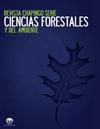Relationship between climate variability and radial growth of Pinus montezumae Lamb. in Coyuca de Catalán, Guerrero
IF 0.5
4区 农林科学
Q3 Agricultural and Biological Sciences
Revista Chapingo Serie Ciencias Forestales Y Del Ambiente
Pub Date : 2020-12-01
DOI:10.5154/r.rchscfa.2020.03.012
引用次数: 1
Abstract
Introduction: Understanding the dendroclimatic potential of a species allows us to reconstruct the climate variability in the latitudes and altitudes of its distribution. Objective: To determine the potential of Pinus montezumae Lamb. to reconstruct climatic variables. Materials and methods: A total of 80 samples were extracted with a Pressler increment borer and dated, allowing growth rates to be generated. Average monthly rainfall and minimum and maximum temperature were obtained, and a response function analysis between growth rates and climate data was conducted. Results and discussion: Dated samples represented 75 % of the total. The COFECHA program indicated a correlation between series of r = 0.57 (P < 0.01) and a mean sensitivity of 0.31; P. montezumae is sufficiently sensitive to record climate variability. Three chronologies (standard, residual and arstan) covering 228 years (1790-2017) were generated for each of the three growth rates (total ring, early and latewood). The response function analysis showed that it is possible to reconstruct the spring rainfall and the May-July maximum temperature based on the total ring (r = 0.66; P Conclusion: Statistical parameters indicate that P. montezumae is an adequate proxy source for climate variability reconstruction studies.气候变率与蒙特松径向生长的关系在科尤卡州Catalán,格雷罗州
引言:了解一个物种的树木气候潜力可以让我们重建其分布的纬度和海拔的气候变化。目的:测定山松羔羊的潜力。重建气候变量。材料和方法:用Pressler增量镗床提取总共80个样本,并确定日期,从而产生生长速率。获得了月平均降雨量和最低和最高温度,并对生长速率和气候数据之间的响应函数进行了分析。结果和讨论:过期样本占总数的75%。COFCHA程序显示,r系列=0.57(P<0.01)与0.31的平均灵敏度之间存在相关性;P.montezumae对记录气候变化非常敏感。三种生长速率(总年轮、早期和晚期木材)中的每一种都产生了三个年表(标准年表、残差年表和阿尔斯坦年表),涵盖228年(1790-2017年)。响应函数分析表明,基于总环(r=0.66;P结论:统计参数表明,P.montezumae是气候变异性重建研究的一个合适的替代来源。
本文章由计算机程序翻译,如有差异,请以英文原文为准。
求助全文
约1分钟内获得全文
求助全文
来源期刊
CiteScore
1.20
自引率
16.70%
发文量
0
审稿时长
>12 weeks
期刊介绍:
The Revista Chapingo Serie Ciencias Forestales y del Ambiente (RCHSCFA) is a scientific journal that aims to raise awareness of high-quality research products related to forest, arid, temperate and tropical environments in the world. Since its foundation in 1994, the RCHSCFA has served as a space for scientific dissemination and discussion at a national and international level among academics, researchers, undergraduate and graduate students, forest managers and public/private entities that are interested in the forest environment.
All content published in the journal first goes through a strict triple-blind review process and is published in the following formats: Scientific Articles, Review Articles, Methodologies, Technical or Technological Notes.

 求助内容:
求助内容: 应助结果提醒方式:
应助结果提醒方式:


